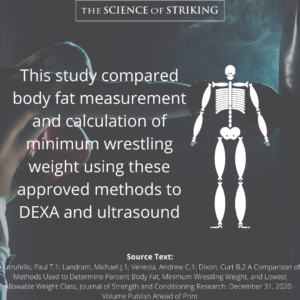The NCAA instigated the wrestling weight management program (WMP) in 1998 in response to the deaths of 3 collegiate wrestlers. Under this program, athletes are permitted to lose a maximum weight of 1.5% off-season body mass per week. There have been concerns over the intertester reliability, measurement validity and appropriateness of the prediction equations.
This study sought to compare measurements taken using the currently approved methods of skinfolds (SF) and air displacement plethysmography (ADP), with the currently non-approved methods of dual x-ray absorptiometry (DXA) and ultrasound (US). 31 male athletes were assessed with all four methods, then, using 5% BF as the lower limit, their minimum competition weight was calculated. A urine specific gravity test (USG) was conducted to assess hydration levels, with 1.02 set as a cut-off.
%BF determined by DXA (20.5%) and US (19.2) were greater than that determined by SF (17.6) and ADP (17.4). The minimum wrestling weight determined by DXA (68.6kg) and US (69.3) were lower than that determined by SF (70.8) and ADP (70.9).
DXA is viewed as a more valid and reliable method of measurement, and is often utilised in research. Because of this, it may be seen as a suitable alternative to the currently approved methods. However, because its use may determine a lower minimum wrestling weight, further study needs to be undertaken to test the safety of guidelines based on this method, and may require a modification of the relevant formulae.
Cutrufello, Paul T.1; Landram, Michael J.1; Venezia, Andrew C.1; Dixon, Curt B.2 A Comparison of Methods Used to Determine Percent Body Fat, Minimum Wrestling Weight, and Lowest Allowable Weight Class, Journal of Strength and Conditioning Research: December 31, 2020 – Volume Publish Ahead of Print
#thescienceofstriking #wrestling #grappling #weightcutting #sportsnutrition



